
Wings is a 1927 and 1928 American silent film known for winning the first Academy Award for Best Picture. The film was re-released in 1928 with a synchronized musical score with sound effects. It was released in both sound-on-disc and sound-on-film formats. The film stars Clara Bow, Charles "Buddy" Rogers, and Richard Arlen. Rogers and Arlen portray World War I combat pilots in a romantic rivalry over a woman. It was produced by Lucien Hubbard, directed by William A. Wellman, and released by Paramount Famous Lasky Corporation. Gary Cooper appears in a small role, which helped launch his career in Hollywood.

Laura is a 1944 American film noir produced and directed by Otto Preminger. It stars Gene Tierney, Dana Andrews, and Clifton Webb along with Vincent Price and Judith Anderson. The screenplay by Jay Dratler, Samuel Hoffenstein, and Betty Reinhardt is based on the 1943 novel Laura by Vera Caspary. Laura received five nominations for the Academy Awards, including for Best Director, winning for Best Black and White Cinematography.

The Ox-Bow Incident is a 1943 American Western film directed by William A. Wellman, starring Henry Fonda, Dana Andrews and Mary Beth Hughes, with Anthony Quinn, William Eythe, Harry Morgan and Jane Darwell. Two cowboys arrive in a Western town, when news arrives that a local rancher has been murdered and his cattle stolen. The townspeople, joined by the two cowboys and cowboys from other ranches, form a posse to catch the perpetrators. They find three men in possession of the cattle, and are determined to see justice done on the spot.

Gene Eliza Tierney was an American film and stage actress. Acclaimed for her great beauty, she became established as a leading lady. Tierney was best known for her portrayal of the title character in the film Laura (1944), and was nominated for an Academy Award for Best Actress for her performance as Ellen Berent Harland in Leave Her to Heaven (1945).
Thunderbird, thunder bird or thunderbirds may refer to:

Darryl Francis Zanuck was an American film producer and studio executive; he earlier contributed stories for films starting in the silent era. He played a major part in the Hollywood studio system as one of its longest survivors. He produced three films that won the Academy Award for Best Picture during his tenure.

Tyrone Edmund Power III was an American actor. From the 1930s to the 1950s, Power appeared in dozens of films, often in swashbuckler roles or romantic leads. His better-known films include Jesse James, The Mark of Zorro, Marie Antoinette, Blood and Sand, The Black Swan, Prince of Foxes, Witness for the Prosecution, The Black Rose, and Captain from Castile. Power's own favorite film among those that he starred in was Nightmare Alley.
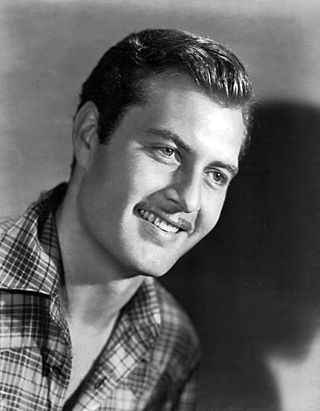
George Montgomery was an American actor, best known for his work in Western films and television. He was also a painter, director, producer, writer, sculptor, furniture craftsman, and stuntman. He was married to Dinah Shore and was engaged to Hedy Lamarr.

The Way to the Stars is a 1945 Anglo-American black-and-white Second World War drama film made by Two Cities Films. The film was produced by Anatole de Grunwald, directed by Anthony Asquith, and stars Michael Redgrave, John Mills, Rosamund John, and Stanley Holloway. In the United States it was shortened by 22 minutes, and the shortened version was distributed by United Artists under the title Johnny in the Clouds.

William Augustus Wellman was an American film director, producer, screenwriter, actor and military pilot. He was known for his work in crime, adventure, and action genre films, often focusing on aviation themes, a particular passion. He also directed several well-regarded satirical comedies. His 1927 film, Wings, was the first film to win an Academy Award for Best Picture at the 1st Academy Awards ceremony.
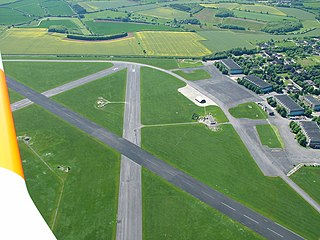
Royal Air Force Little Rissington or more simply RAF Little Rissington is an Royal Air Force satellite station in Gloucestershire, England. It was once home to the Central Flying School, the Vintage Pair and the Red Arrows.

Falcon Field is in an airport located in Maricopa County, Arizona. It was originally built 6 miles northeast of Mesa, which owns it. However, it is now within city limits. The National Plan of Integrated Airport Systems for 2017–2021 categorized it as a reliever airport. Scheduled service to Bullhead City on Western Express Air ended in January 2007.
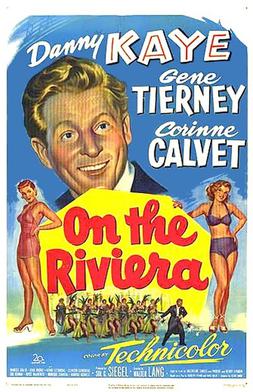
On the Riviera is a 1951 Technicolor musical comedy film made by 20th Century Fox. Directed by Walter Lang and produced by Sol C. Siegel from a screenplay by Valentine Davies and Phoebe and Henry Ephron, it is the studio's fourth film based on the 1934 play The Red Cat by Rudolph Lothar and Hans Adler. This version stars Danny Kaye, Gene Tierney and Corinne Calvet, with Marcel Dalio, Henri Letondal and Sig Ruman.

Gallant Journey is a 1946 American historical film written, produced and directed by William A. Wellman and starring Glenn Ford, Janet Blair and Charles Ruggles. The film is a biopic of the early U.S. aviation pioneer John Joseph Montgomery. Gallant Journey depicts his efforts to build and fly gliders, from his childhood through to his death in 1911. The chief stunt pilot for the film was Paul Mantz. It was produced and distributed by Columbia Pictures. It is also known by the alternative title The Great Highway

Thunderbird Field was a military airfield in Glendale, Arizona, used for contract primary flight training of Allied pilots during World War II. Created in part by actor James Stewart, the field became part of the United States Army Air Forces training establishment just prior to American entry into the war and was re-designated Thunderbird Field #1 after establishment of Thunderbird Field#2 at nearby Scottsdale, on 22 June 1942. Thunderbird # 1 is located southeast of the intersection of West Greenway Road & North 59th Avenue in Glendale, Arizona.
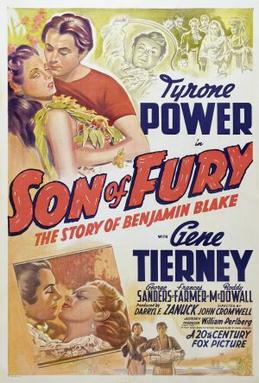
Son of Fury: The Story of Benjamin Blake is a 1942 American south seas adventure film directed by John Cromwell and starring Tyrone Power. The film was adapted from Edison Marshall's 1941 historical novel Benjamin Blake. It is notable as the last film Frances Farmer appeared in before her legal problems and eventual commitment to psychiatric hospitals until 1950.

The Legion of the Condemned is a 1928 American silent film directed by William A. Wellman and produced by Jesse L. Lasky, Wellman, and Adolph Zukor and distributed by Paramount Pictures. Written by former World War I flight instructor John Monk Saunders and Jean de Limur, with intertitles by George Marion, Jr., the film stars Fay Wray and Gary Cooper.

The Iron Curtain is a 1948 American thriller film starring Dana Andrews and Gene Tierney, directed by William A. Wellman. It was the first film on the Cold War. The film was based on the memoirs of Igor Gouzenko. Principal photography was done on location in Ottawa, Ontario, Canada by Charles G. Clarke. The film was later re-released as Behind the Iron Curtain.
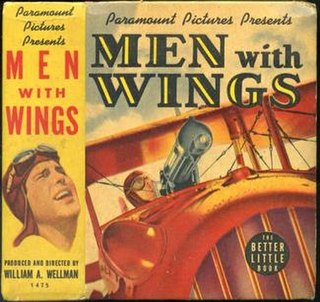
Men with Wings is a 1938 American Technicolor war film, directed by William A. Wellman and starring Fred MacMurray, Ray Milland, and Louise Campbell. Donald O'Connor also has a small part as the younger version of MacMurray's character. The two would soon star in the film Sing You Sinners together along with Bing Crosby.

International Squadron is a 1941 American war film directed by Lewis Seiler and Lothar Mendes that starred Ronald Reagan, Olympe Bradna and in his final film, James Stephenson. The film is based on the Eagle Squadrons, American pilots who volunteered to fly for the Royal Air Force during World War II. International Squadron featured noted Hollywood pilot Paul Mantz who acted as the film's aerial coordinator and flew during the production.




















